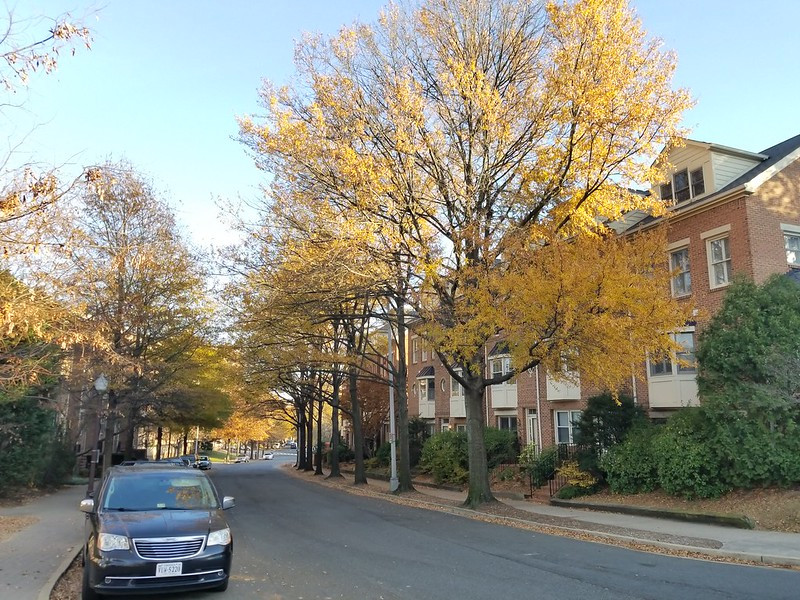A divisive Arlington housing proposal can help save the climate and our wallets

Late 20th Century rowhouses, Arlington VA by Beyond DC licensed under Creative Commons.
Who wouldn’t choose a safer climate, more affordable housing, and a diverse community?
A divisive proposal to expand “Missing Middle” housing in Arlington could do just that: shrink our carbon footprint, expand our housing options, and save millions of dollars, especially if paired with supportive policies.
During my daily commute I walk through Arlington’s upscale Lyon Village neighborhood. Lawns along this walk are currently sown with signs reading: “SAVE OUR TREE CANOPY”; “IT ISN’T AFFORDABLE”; “LET ARLINGTONIANS DECIDE.” One morning, I asked myself, “what awful person is trying to remove the trees from these poor folks’ lawns?”
The answer is less nefarious than would at first seem: A county upzoning plan expected to be finalized in December seeks to change the residential makeup of DC’s nearest neighbor, and in doing so, simultaneously battle a housing shortage and climate change.
First, a little background. In the wake of a New Deal construction boom, Arlington banned row houses in 1938 to preserve its suburban identity. This ban came at a time of racially restrictive covenants and discriminatory lending, all of which drove exclusionary ownership patterns that remain today.
Now, eight decades since the rowhouse ban, three-quarters of the county’s land is occupied by single-family detached homes that make up only one-quarter of the county’s housing stock, driving a shortfall that has radically increased costs, making housing unaffordable, particularly for Black Arlingtonians.
To help alleviate the shortage, Arlington is conducting a study for upzoning residential neighborhoods to allow “Missing Middle” housing—townhouses, duplexes, cottage courts, and the like. The proposal is divisive, with fervent pushback based on fears of overcrowding and changes to neighborhood composition.
But beyond creating affordable housing and diversifying our community, Missing Middle could reduce the county’s carbon footprint while saving residents millions.
Missing Middle reduces Arlington’s carbon output by thousands of tons
Upzoning proponents herald its ability to lower housing costs and improve equity, but mid-density housing’s effect on energy use is less well known.
Alternative housing would both improve new home energy use and reduce car dependency. Missing Middle housing like townhomes and multi-family dwellings use between 8 and 33% less energy. Further, commuters living in these homes rely on single-occupancy car travel 14% less often than residents of single-family detached houses do.
As a modeling analyst at nonpartisan climate policy firm Energy Innovation, I used our Virginia Energy Policy Simulator to investigate how upzoning would affect Arlington’s carbon footprint. I found that the proposal could reduce the county’s planet-heating greenhouse gas emissions by nearly 70,000 tons of carbon dioxide equivalent (CO2e) through 2050. That’s roughly equal to 400,000 locals switching to energy-efficient LED lights or 300,000 taking up recycling.
Smart policy can save the tree canopy and abate new home construction emissions
Missing Middle opponents often herald the tree canopies of single-family residential zones, but such housing isn’t always a tree saver. Tree canopy coverage in Arlington’s single-family neighborhoods actually fell by 8% between 2008 and 2016, often due to residents tearing down older homes to build bigger ones.
Image by Google Maps. Change in tree canopy over the course of ten years (2012-2022) by the author.

Instead of banning townhomes or duplexes, the county should improve its land use policy to revitalize our shrinking tree canopy. By protecting trees on newly upzoned properties and planting trees on existing land, we can cut planet-warming emissions while also cleaning our air and cooling our streets.
Graph showing effects of various modes of emissions reductions by the author.
Arlington should also encourage green-building construction through updated building codes. The U.S. Department of Energy recently announced $225 million in funding to help local governments improve codes and support building homes that use less energy. These codes would both slash monthly energy bills and offset emissions generated during construction, pushing the upzoning proposal’s emissions savings past 100,000 tons CO2e through 2050.
Save money by reducing fuel costs
Lastly, my analysis found that upzoning could save $94 million, or as much as $116 million if green building codes and tree planting were also enacted. These savings—a sum of capital and operational expenses—could pass through to residents or be used to invest in improving our shared home.
Bringing these changes to life
The County Board’s Missing Middle conversations have spurred fierce debate as a board member election approaches, with each of the three candidates taking different stances on the topic.
If you want a safer climate, more trees, greater diversity, and affordable housing, now is the time to have your voice heard. Vote and let the Board know you support Missing Middle. Backing local policies will shape our climate future much more than your recycling bin will.
